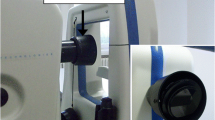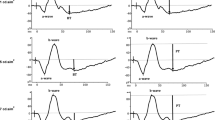Abstract
Purpose
Patients with an eye disease often report nyctalopia, hemianopia, and/or photophobia. We hypothesized that such symptoms are related to the disease impacting the dynamic range of lightness perception (DRL). However, there is currently no standardized approach for measuring DRL for clinical use. We developed an efficient measurement method to estimate DRL.
Study design
Clinical trial
Methods
Fifty-five photophobic patients with eye disease and 46 controls participated. Each participant judged the appearance of visual stimuli, a thick bar with luminance that gradually changed from maximum to minimum was displayed on uniform background. On different trials the background luminance changed pseudo-randomly between three levels. The participants repeatedly tapped a border on the bar that divided the appearance of grayish white/black and perfect white/black. We defined the DRL as the ratio between the luminance values at the tapped point of the border between gray and white/black.
Results
The mean DRL of the patients was approximately 15 dB, significantly smaller than that of the controls (20 dB). The center of each patient's DRL shift depending on background luminance, which we named index of contextual susceptibility (iCS), was significantly larger than controls. The DRL of retinitis pigmentosa was smaller than controls for every luminance condition. Only the iCS of glaucoma was significantly larger than controls.
Conclusions
This measurement technique detects an abnormality of the DRL. The results support our hypothesis that the DRL abnormality characterizes lightness-relevant symptoms that may elucidate the causes of nyctalopia, hemeralopia, and photophobia.






Similar content being viewed by others
References
Dowling JE, Wald G. Vitamin a Deficiency and Night Blindness. Proc Natl Acad Sci USA. 1958;44:648–61.
Kawamura S, Murakami M. Calcium-dependent regulation of cyclic GMP phosphodiesterase by a protein from frog retinal rods. Nature. 1991;349:420–3.
Yau KW. Phototransduction mechanism in retinal rods and cones. The Friedenwald Lecture. Invest Ophthalmol Vis Sci. 1994;35:9–32.
Vessey JP, Stratis AK, Daniels BA, Da Silva N, Jonz MG, Lalonde MR, et al. Proton-mediated feedback inhibition of presynaptic calcium channels at the cone photoreceptor synapse. J Neurosci. 2005;25:4108–17.
Barnes S, Merchant V, Mahmud F. Modulation of trasmission gain by protons at the photoreceptor output synapse. Proc Natl Acad Sci USA. 1993;90:10081–5.
Rieke F. Temporal contrast adaptation in salamander bipolar cells. J Neurosci. 2001;21:9445–54.
Kim KJ, Rieke F. Temporal contrast adaptation in the input and output signals of salamander retinal ganglion cells. J Neurosci. 2001;21:287–99.
Manookin MB, Demb JB. Presynaptic mechanism for slow contrast adaptation in mammalian retinal ganglion cells. Neuron. 2006;50:453–64.
Brown SP, Masland RH. Spatial scale and cellular substrate of contrast adaptation by retinal ganglion cells. Nat Neurosci. 2001;4:44–51.
Ohzawa I, Sclar G, Freeman RD. Contrast gain control in the cat’s visual system. J Neurophysiol. 1985;54:651–67.
Solomon SG, Peirce JW, Dhruv NT, Lennie P. Profound contrast adaptation early in the visual pathway. Neuron. 2004;42:155–62.
Gardner JL, Sun P, Waggoner RA, Ueno K, Tanaka K, Cheng K. Contrast adaptation and representation in human early visual cortex. Neuron. 2005;47:607–20.
van den Berg TJ. On the relation between glare and straylight. Doc Ophthalmol. 1991;78:177–81.
Heckaman R, Fairchild M, in 17th Color and Imaging Conference Final Program and Proceedings. (Society for Imaging Science and Technology, 2009), 7:8–14.
Xiao F, DiCarlo J, Catrysse P, Wandell B, in 10th Color and Imaging Conference Final Program and Proceedings. (Society for Imaging Science and Technology, 2002), vol. 6, pp. 337–42.
Radonjic A, Allred SR, Gilchrist AL, Brainard DH. The dynamic range of human lightness perception. Curr Biol. 2011;21:1931–6.
Gilchrist A, Kossyfidis C, Bonato F, Agostini T, Cataliotti J, Li X, et al. An anchoring theory of lightness perception. Psychol Rev. 1999;106:795–834.
Wandell B, Foundations of Vision. Sinauer Presss, Sunderland, MA: pp.287–339
Hartong DT, Berson EL, Dryja TP. Retinitis pigmentosa. Lancet. 2006;368:1795–809.
Lindberg CR, Fishman GA, Anderson RJ, Vasquez V. Contrast sensitivity in retinitis pigmentosa. Br J Ophthalmol. 1981;65:855–8.
Dul M, Ennis R, Radner S, Lee B, Zaidi Q. Retinal adaptation abnormalities in primary open-angle glaucoma. Invest Ophthalmol Vis Sci. 2015;56:1329–34.
Bierings R, de Boer MH, Jansonius NM. Visual performance as a function of luminance in glaucoma: the de Vries-Rose, Weber’s, and Ferry-Porter’s law. Invest Ophthalmol Vis Sci. 2018;59:3416–23.
Acknowledgements
We thank Scott Mooney, Jonathan Winawer, and Brian A. Wandell for helpful discussion. Our study was supported by the grant of AMED (Research and Development Grants for Comprehensive Research for Persons with Disabilities, Japan Agency for Medical Research and Development: 15dk0310013h0003 to S.N.), Japan Society for the Promotion of Science (JSPS) KAKENHI (JP18K16939 to H.H.), Charitable Trust Fund for Ophthalmic Research in Commemoration of Santen Pharmaceutical’s Founder (H.H.) and Tokai Optical Co. Ltd. Some parts of this study were reported on the 25th Annual Meeting of Vision Rehabilitation (June, 2016), the Winter Meeting of Vision Society of Japan (January, 2017) and the 15th Asian Pacific Conference on Vision (July, 2019).
Author information
Authors and Affiliations
Corresponding author
Ethics declarations
Conflicts of interest
H. Horiguchi, Grant (Next Vision); E. Suzuki, None; H. Kubo, Grant (Next Vision); T. Fujikado, Grant (Next Vision); S. Asonuma, Grant (Next Vision); C. Fujimoto, Grant (Next Vision); M. Tatsumoto, Grant (Next Vision); T. Fukuchi, Grant (Santen, HOYA, Atsuzawa Proteze, Shiga Medical Instruments, Union Medical, Retina Kitanihon, Abbott, Otsuka, Senju, Alcon, Kowa, Next Vision), Lecture fee (Santen, Abbott, Otsuka, Senju, Alcon, Kowa, Pfizer, Glaukos, AbbVie, Nitten, Alcon, Nidek, Novartis); Y. Sakaue, Grant (Next Vision); M. Ichimura, Grant (Next Vision); Y. Kurimoto, Grant (TOMEY, Santen, HOYA, Novartis, AMO, Senju, Bayer, Kowa, Next Vision), Financial support (Santen, HOYA, Novartis, AMO, Senju), Lecture fee (Bayer, Kowa, Alcon); M. Yamamoto, Grant (Next Vision); S. Nakadomari, Grant (Next Vision, Tokai Optical).
Additional information
Publisher's Note
Springer Nature remains neutral with regard to jurisdictional claims in published maps and institutional affiliations.
Corresponding Author: Hiroshi Horiguchi
About this article
Cite this article
Horiguchi, H., Suzuki, E., Kubo, H. et al. Efficient measurements for the dynamic range of human lightness perception. Jpn J Ophthalmol 65, 432–438 (2021). https://doi.org/10.1007/s10384-020-00808-2
Received:
Accepted:
Published:
Issue Date:
DOI: https://doi.org/10.1007/s10384-020-00808-2




